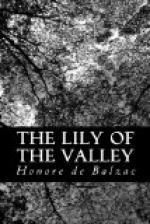Without knowing why, my eyes reverted ever to that white spot, to the woman who shone in that garden as the bell of a convolvulus shines amid the underbrush, and wilts if touched. Moved to the soul, I descended the slope and soon saw a village, which the superabounding poetry that filled my heart made me fancy without an equal. Imagine three mills placed among islands of graceful outline crowned with groves of trees and rising from a field of water,—for what other name can I give to that aquatic vegetation, so verdant, so finely colored, which carpeted the river, rose above its surface and undulated upon it, yielding to its caprices and swaying to the turmoil of the water when the mill-wheels lashed it. Here and there were mounds of gravel, against which the wavelets broke in fringes that shimmered in the sunlight. Amaryllis, water-lilies, reeds, and phloxes decorated the banks with their glorious tapestry. A trembling bridge of rotten planks, the abutments swathed with flowers, and the hand-rails green with perennials and velvet mosses drooping to the river but not falling to it; mouldering boats, fishing-nets; the monotonous sing-song of a shepherd; ducks paddling among the islands or preening on the “jard,”—a name given to the coarse sand which the Loire brings down; the millers, with their caps over one ear, busily loading their mules,—all these details made the scene before me one of primitive simplicity. Imagine, also, beyond the bridge two or three farm-houses, a dove-cote, turtle-doves, thirty or more dilapidated cottages, separated by gardens, by hedges of honeysuckle, clematis, and jasmine; a dunghill beside each door, and cocks and hens about the road. Such is the village of Pont-de-Ruan, a picturesque little hamlet leading up to an old church full of character, a church of the days of the Crusades, such a one as painters desire for their pictures. Surround this scene with ancient walnut-trees and slim young poplars with their pale-gold leaves; dot graceful buildings here and there along the grassy slopes where sight is lost beneath the vaporous, warm sky, and you will have some idea of one of the points of view of this most lovely region.
I followed the road to Sache along the left bank of the river, noticing carefully the details of the hills on the opposite shore. At length I reached a park embellished with centennial trees, which I knew to be that of Frapesle. I arrived just as the bell was ringing for breakfast. After the meal, my host, who little suspected that I had walked from Tours, carried me over his estate, from the borders of which I saw the valley on all sides under its many aspects,—here through a vista, there to its broad extent; often my eyes were drawn to the horizon along the golden blade of the Loire, where the sails made fantastic figures among the currents as they flew before the wind. As we mounted a crest I came in sight of the chateau d’Azay, like a diamond of many facets in a setting of the Indre,




